The aroma and delectable flavor of the Feijoa sellowiana plant makes it a favorite amongst gardening enthusiasts throughout Australia. Not only is Feijoa fruit extremely easy to grow and care for, but also serves as an incredible decorative tree owing to its vibrant reddish-pink flowers.
It's fruit is highly versatile and super easy to grow in the Australian climate. In this guide, we’ve covered all you need to know about growing a healthy Feijoa tree, from seeds to planting, harvesting, pest care, additional tips, and more!
More...

Nathan Schwartz of Aussie Green Thumb checking a Feijoa flower
What is a Feijoa Tree?
Also known as ‘Pineapple Guava’, Feijoa sellowiana is a beautiful, evergreen shrub bearing delicious, tropical tasting fruits. It is native to Uruguay, northern Argentina, the highlands of southern Brazil and Colombia.
Owing to its lush foliage with silver and green leaves, and attractive red flowers, this plant is often cultivated as an ornamental tree. The best thing about this plants is that they are considered ‘hardy’ and unfussy plant, meaning they can handle a wide range of growing conditions.
Although they can be planted at any point throughout the year, they grow best in cool winters and moderate summers. If given up to 50 chill hours, the plant yields the best quality fruit. It is ideal to plant them in autumn or winter in a sunny, well-drained spot.
Feijoa Plant Varieties
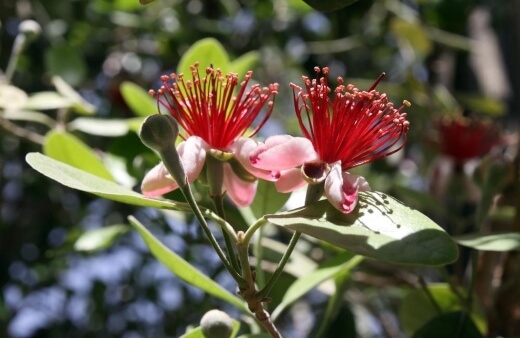
There are a wide range of varieties available. Some of the basic ones are:
- Feijoa ‘Apollo’. This is a semi self-fertile variety that produces medium to large oval fruit. It is a mid to late season bloomer and performs better if other varieties are planted nearby. This variety is generally very productive and is an upright tree that can grow up to 2.5 meters tall.
- Feijoa ‘Triumph’. It is a late season bloomer with vigorous upright growth. It produces large oval fruit with juicy cream flesh, a tangy taste and mild aroma.
- Feijoa ‘Nazematze’. It is a self-fertile variety and produces very large oval shaped fruit with sweet, flavorful flesh. It yields more fruit when paired with another pollinating variety.
- Feijoa ‘Gemini’. This variety is pollinated by Apollo, and ripens in early fall. It produces fruits earlier than Apollo and generally gives an amazing yield, even though the fruit are smaller than Apollo.
- Feijoa ‘Anatoki’. This is an early season variety. It is very attractive and does well as an ornamental tree. It is not self-pollinating but produces large, round fruit that is extremely sweet and delicious.
- Feijoa ‘Coolidge’. This is a fully self-fertile variety and generally produces a high yield of medium-sized fruit.
- Feijoa ‘Mammoth’. This variety is known to produce large-sized, oval fruit with a delectable flavor. It is self-fertile but performs better with other varieties, such as Triumph.
There are many other varieties, from Top Star and Kakariki to Kaiteri, Pineapple Gum, Choiceana and Bambina, just to name a few. The Mammoth, Triumph and Nazematze varieties are especially popular in Australia.
Pineapple Guava Features and Growth Rate
An average Feijoa tree is about 15 feet (5 meters) to 25 feet (7.6 meters) high and the dull-colored fruit is approximately 2 inches in length. They can be pruned to keep them to a desired height in your garden, and you can also shape them to be a shrub. However, clipping them produces lower fruit yield and destroys their natural shape.
Pineapple Guava’s growth rate highly varies according to its environment. It grows faster in humid climate and loam soil, flowering up to four times in warmer climates and twice in colder ones.
The overall growth rate is generally moderate, and the fruit starts forming anywhere from about four to six months after flowering.
How to Grow Feijoa in Australia

Growing Feijoa From Seeds
This plant can easily be grown from seeds, but this is a fiddly process and the seeds may not always be of type, so it isn’t the best method. However, if you do wish to use seeds, you can do so by following this guide.
- Squeeze the pulp into a container and cover it with water.
- Leave it to ferment for at least four days.
- Rinse pulp in a sieve to expose the seeds.
- Pick out seeds and allow them to dry completely.
- The seeds can be stored for up to a year without planting.
How to Propagate Feijoa
You can easily propagate Feijoa using softwood cuttings. Make sure to dip the plant cutting in a rooting hormone before planting.
Planting Feijoa
The best time of year to plant is spring or early summer when the temperatures are cool and the ground is workable. Avoid planting if there is a frost or the ground is too dry.


Get Your Free Guide:
Master Growing Australian Natives eBook
A Must Have Complete Guide for Every Australian Garden
Get Your Free Guide:
Master Growing Australian Natives eBook
A Must Have Complete Guide for Every Australian Garden
Plants that are subjected to cold winters after being planted tend to produce more fruit, and need about 50 hours of chilling for optimal yield. The best time to plant is early morning, so the plant isn’t exposed to very harsh sunlight right away.
Planting in the Garden
- Prepare a planting site in full-sun with free draining soil. Make sure the site is adequately sheltered from prevailing wind.
- Make sure the soil is well-manured.
- Dig a hole that is about twice the depth and width of the root of your plant.
- Add a cupful of fertiliser to the base of the hole.
- Gently loosen the root of your plant and place it in the centre of the hole.
- Carefully spread the roots out in all directions.
- Press the fertiliser gently around the base of the plant.
- Firm in the soil so there are no air pockets.
- Generously water the soil after planting.
- Fertilise with a high phosphorus liquid fertiliser.

Planting Feijoa in a Container
Container grown Feijoa should be planted in spring or early summer. They grow well in pots but will need a lot of water and fertiliser, and will be of limited size.
Choose a container about 24 inches wide and deep, and repot twice a year to prevent roots from becoming tangled and crowded.
- Half fill your container or pot with well-manured compost.
- Loosen the plant’s root ball and carefully place it in the centre of the container.
- Make sure the soil mark is at the surface level of the surrounding stem.
- Add fertiliser and press it into the base of the plant.
- This should be at the same level as it was in the previous container.
- Water well after planting.
Sun and Soil Requirements
Feijoa trees thrive best in full sun, but can tolerate partial shade. Too much shade will affect the fruit yield greatly. Protect the plant from scorching hot sun.
They grow best when the average temperatures are between 80 to 90 degrees, but can withstand temperatures as low as 15 degrees. Make sure to plant in compost rich soil, well-drained and loamy soil.
The pH of the soil should be between 5.5 and 7. Do not plant them in low spots where snow or frost can collect, as this may harm the plant in winter months.
Spacing
For most varieties, it is best to plant the trees about 10 to 15 feet apart. If you are planting a larger-sized variety, leave a space of at least 20 feet to prevent crowding and ensure adequate airflow.
Feijoa sellowiana Care Guide
Caring for Feijoa is extremely easy, as they aren’t particularly fussy plants. However, in order to get the best possible fruit yield, they must receive enough water during the flowering and fruiting seasons.
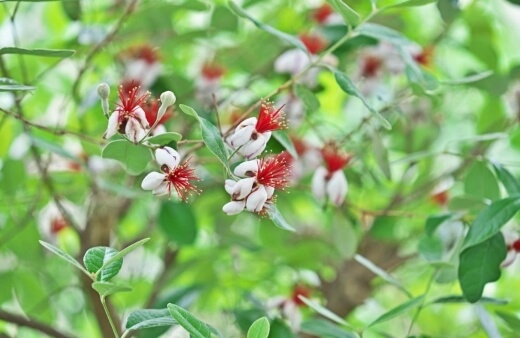
Mulching Pineapple Guava
Make sure to keep the base of the plant weed-free and mulched. Mulch around the base of the plant using aged compost to prevent evaporation of water from the soil.
Fertiliser
These plants don’t necessarily require too much feeding, as they are slow growers. A balanced all purpose fertiliser every two months should do the work. (Our Yates Thrive Fertiliser review will be quite helpful for this task.)
Watering
This plants require deep and heavy watering, especially during the fruiting and flowering seasons. You can also give them water with seaweed solution just before and right after they fruit for additional nutrition.
Pruning Feijoa
Generally, this plant doesn’t require pruning, but you can keep it trimmed back into a hedge if you require. You can prune lightly in the summer after the fruiting season, as this helps encourage new growth.
Remove dead and broken branches and thin out any crowded growth to ensure that adequate sunlight reaches the growing plant.
(Check out our review on the best hedge trimmers in Australia all available online.)
Harvesting Pineapple Guava
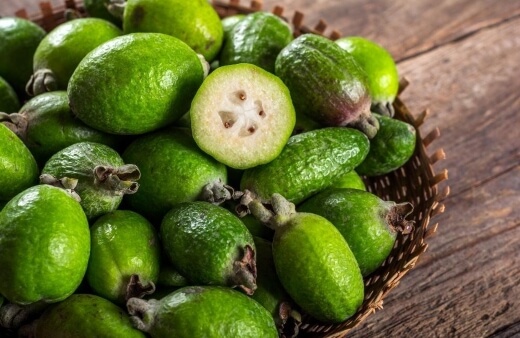
Feijoa fruit should not be picked off the plant, as it will be unripe and bitter. They don’t undergo a significant color change as they mature, so you’ll be unable to identify them in this regard.
The best course of action is to wait for the fruit to ripen completely, as it will then fall to the ground on its own. You can encourage the falling by lightly shaking the tree every few days to gather the ripe fruit.
Ripe Feijoa is soft to the touch and gives in to pressure easily. The fruit will continue to ripen at room temperature, so make sure to consume it quickly. You can store it in a plastic bag in the refrigerator for up to one week.
To prevent the flesh from turning brown, you can dip the peeled fruit in some lemon water to keep it fresh.
Feijoas can be eaten in salads, and can also be cooked into cakes, wine, bread, chutneys, jams and so much more. Here are some Feijoa recipes to give you some cooking inspiration.
However, you can also simply scoop the soft flesh up with a spoon as a yummy and healthy snack!
Feijoa sellowiana Diseases and Pests
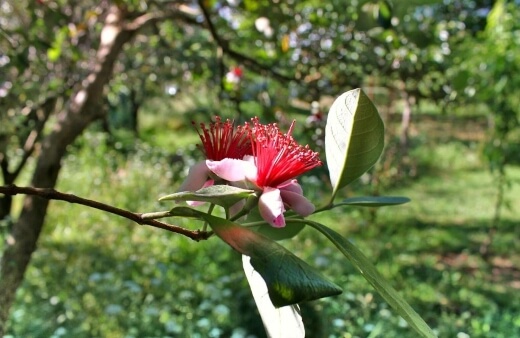
This is an extremely hardy plant, and is resistant to most pests and diseases. However, there are some pests you must watch out for.
- Fruit Flies - Make sure to keep the area around your tea clean at all times to prevent fruit fly infestation, as they can hinder plant growth significantly.
Female fruit flies can lay eggs below the skin of the fruit. Upon hatching, they may nibble on the fruit and cause it to die.
Use pheromone traps to identify if your fruit is infested with fruit flies. You can then use a neem oil spray to get rid of them. - Guava Moth - These moths are incredibly destructive to the plant and occur greatly in Australia, so you must watch out for them. The adult moth can lay its egg in a little hole in the fruit, and a caterpillar then chews its way out of the fruit, making it inedible.
You can prevent guava moth infestations by putting nettings over your plant, and can use moth traps to prevent them from laying eggs in your fruit.
Additional Feijoa Care Tips
- These plants are generally pest resistant after the first three years of growth. Be sure to monitor for pests until then.
- Often, birds may feed on the ripe fruit. You can prevent this using bird netting.
- If you notice any black scale on the stem and branches, use horticultural oil to smother it immediately. If left unattended, scale can cause sooty mold infestations, so it’s best to get rid of it as soon as possible.
Feijoa Frequently Asked Questions

How fast does Feijoa sellowiana grow?
Feijoa sellowiana is a slow-growing plant. It can grow upto 5.5 metres and the fruits generally mature 5 to 6 months after the plant has flowered.
Are feijoas self-pollinating?
Most Feijoa sellowiana varieties are self-pollinating, but some are semi-pollinating and grow best when grown with other varieties.
How long does it take a Feijoa tree to fruit?
Feijoa trees begin to fruit anywhere between 2 to 6 years of age, although this greatly depends on the care and nutrition the plant has been receiving.
Does Feijoa grow in shade?
Feijoa plants thrive best in the sunlight, and some are mildly tolerant to shade. However, scorching hot sun can damage the plant, and they cannot survive in continuous shade.
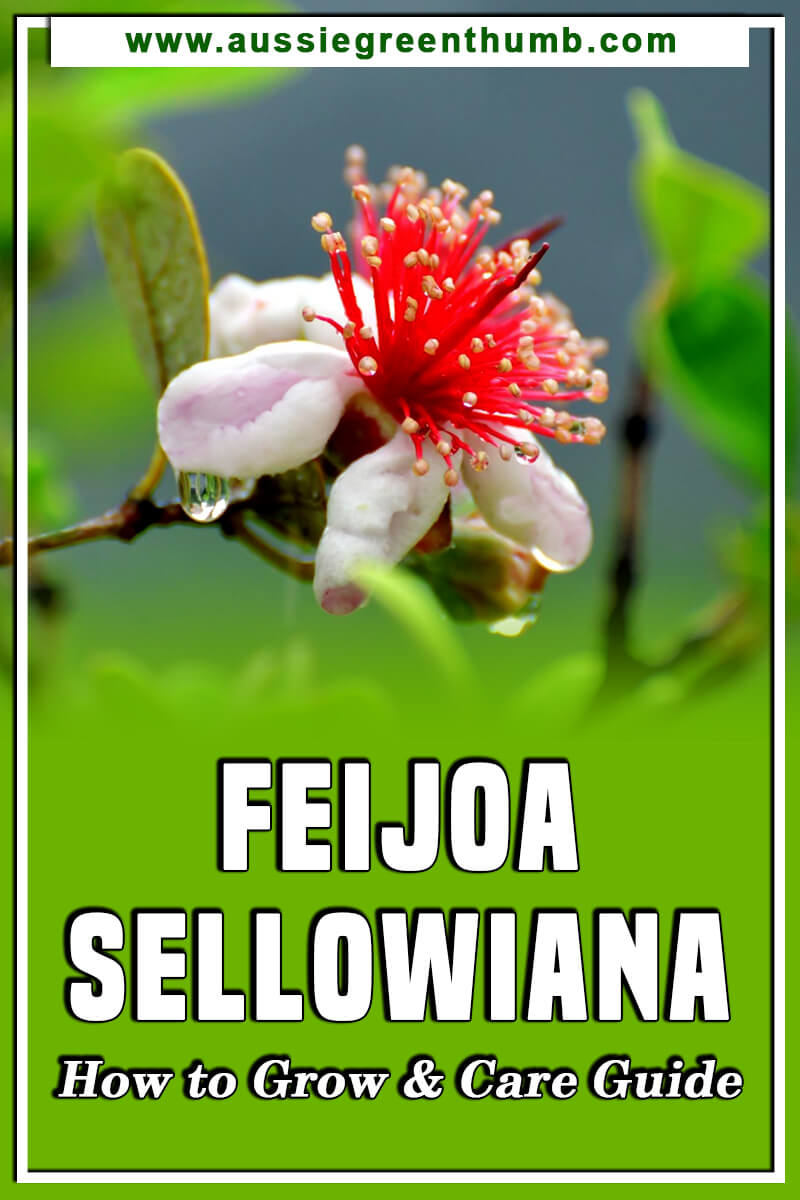
Feijoa is a Tantalizing Addition to Your Garden
With minimal maintenance effort and stunning flowers, this plant is not only a great way to add some personality to your garden but the fruit also makes for a delicious snack.
If you’ve been thinking about growing Feijoa sellowiana but have been hesitant so far, this article is your sign to take that step now!
Published on January 13, 2022 by Maisie Blevins
Last Updated on February 21, 2025





Dear Mrs Blevins,
My name is Meri Armstrong and I have several feijoa trees. Unfortunately every year they now get an infestation of tiny black beetles which make the fruit inedible.
Can you please give me any advice which will eradicate these pests.
Yours sincerely,
Meri Armstrong
Hi Meri,
I’ve never come across this before – not with beetles anyway. Pineapple guava is definitely attractive to fruit flies, and moth caterpillars, but this is unusual. They could, perhaps, be Dried Fruit Beetles (check out this government post about them).
If it is Dried Fruit Beetles, they can be controlled by pheromone lures and various traps. They’re not a native species so there aren’t any natural predators though.
But, before I go down the rabbit hole of Dried Fruit Beetles, if you’ve got any extra information, hopefully I can offer more specific advice. What’s the damage like? Are they feeding on the fruit itself, or damaging its growth by eating at the young shoots?
Have you got pictures of the beetles, or the damage? I really hope we can help with this.
Best regards,
Maisie Blevins